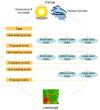Modeling Effects of Vertebrate Host Exclosures and Host-Targeted Acaricides on Lone Star Tick (Amblyomma americanum, L.) Infestations
- PMID: 36558745
- PMCID: PMC9784951
- DOI: 10.3390/pathogens11121412
Modeling Effects of Vertebrate Host Exclosures and Host-Targeted Acaricides on Lone Star Tick (Amblyomma americanum, L.) Infestations
Abstract
We used a spatially explicit model to simulate the potential effects of exclosures and acaricides targeted at medium-sized mammalian hosts on the local distribution and abundance of lone star ticks (Amblyomma americanum) within forestlands of the southeastern United States. Both exclosures and acaricides were successful in markedly reducing the densities of all off-host tick life stages inside the treatment areas. Densities dropped to almost zero immediately inside the edges of the exclosures, with noticeably depressed densities extending outward 30 to 60 m from the exclosures, and the simulated exclosures maintained their effectiveness as their sizes were decreased from 4.5 to 2.25 to 0.8 ha. Densities exhibited a smooth gradient across the edges of the acaricide-treated areas, with depressed densities extending ≈100 m outward from the edges, but with perceptible densities extending ≈60 m inward from the edges; thus, the simulated acaricide areas lost their effectiveness as size was decreased to slightly less than one-half the diameter of the activity range of the targeted host. Our simulation results indicated that off-host nymph densities responded to reductions of medium-sized host densities. These results suggest that targeting acaricides at medium-sized hosts may be an effective, and currently under-utilized, method for tick suppression.
Keywords: disease vectors; simulation models; spatial-temporal dynamics; tick control; tick population dynamics.
Conflict of interest statement
The authors declare no conflict of interest.
Figures





Similar articles
-
Simulation of climate-tick-host-landscape interactions: Effects of shifts in the seasonality of host population fluctuations on tick densities.J Vector Ecol. 2015 Dec;40(2):247-55. doi: 10.1111/jvec.12161. J Vector Ecol. 2015. PMID: 26611958
-
Integrated management strategies for Amblyomma americanum (Acari: Ixodidae) on pastured beef cattle.J Med Entomol. 1994 Jul;31(4):571-85. doi: 10.1093/jmedent/31.4.571. J Med Entomol. 1994. PMID: 7932604
-
Effective control of the motile stages of Amblyomma americanum and reduced Ehrlichia spp. prevalence in adults via permethrin treatment of white-tailed deer in coastal Connecticut, USA.Ticks Tick Borne Dis. 2021 May;12(3):101675. doi: 10.1016/j.ttbdis.2021.101675. Epub 2021 Jan 27. Ticks Tick Borne Dis. 2021. PMID: 33529986
-
The expanding spectrum of disease caused by the Lone Star Tick, Amblyomma americanum.Infez Med. 2021 Sep 10;29(3):378-385. doi: 10.53854/liim-2903-8. eCollection 2021. Infez Med. 2021. PMID: 35146342 Free PMC article. Review.
-
Role of the lone star tick, Amblyomma americanum (L.), in human and animal diseases.Vet Parasitol. 2009 Mar 9;160(1-2):1-12. doi: 10.1016/j.vetpar.2008.10.089. Epub 2008 Oct 28. Vet Parasitol. 2009. PMID: 19054615 Review.
References
LinkOut - more resources
Full Text Sources

